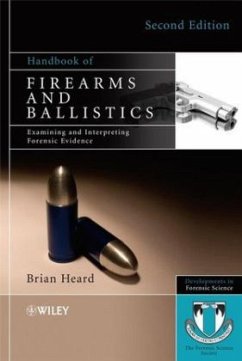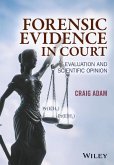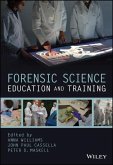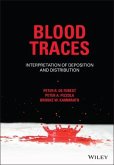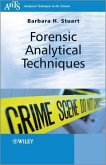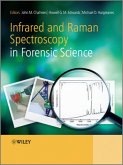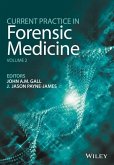- Gebundenes Buch
- Merkliste
- Auf die Merkliste
- Bewerten Bewerten
- Teilen
- Produkt teilen
- Produkterinnerung
- Produkterinnerung
The updated second edition of Handbook of Firearms and Ballistics includes recent developed analytical techniques and methodologies with a more comprehensive glossary, additional material, and new case studies. With a new chapter on the determination of bullet caliber via x-ray photography, this edition includes revised material on muzzle attachments, proof marks, non-toxic bullets, and gunshot residues. Essential reading for forensic scientists, firearms examiners, defense and prosecution practitioners, the judiciary, and police force, this book is also a helpful reference guide for undergraduate and graduate forensic science students.…mehr
Andere Kunden interessierten sich auch für
![Forensic Evidence in Court Forensic Evidence in Court]() Craig AdamForensic Evidence in Court74,99 €
Craig AdamForensic Evidence in Court74,99 €![Forensic Science Education and Training Forensic Science Education and Training]() Forensic Science Education and Training112,99 €
Forensic Science Education and Training112,99 €![Blood Traces Blood Traces]() Peter R. De ForestBlood Traces153,99 €
Peter R. De ForestBlood Traces153,99 €![Forensic Analytical Techniques Forensic Analytical Techniques]() Barbara B. StuartForensic Analytical Techniques187,99 €
Barbara B. StuartForensic Analytical Techniques187,99 €![Infrared and Raman Spectroscopy in Forensic Science Infrared and Raman Spectroscopy in Forensic Science]() Infrared and Raman Spectroscopy in Forensic Science236,99 €
Infrared and Raman Spectroscopy in Forensic Science236,99 €![Current Practice in Forensic Medicine, Volume 2 Current Practice in Forensic Medicine, Volume 2]() Current Practice in Forensic Medicine, Volume 2127,99 €
Current Practice in Forensic Medicine, Volume 2127,99 €![Forensic Anthropology Forensic Anthropology]() Forensic Anthropology165,99 €
Forensic Anthropology165,99 €-
-
-
The updated second edition of Handbook of Firearms and Ballistics includes recent developed analytical techniques and methodologies with a more comprehensive glossary, additional material, and new case studies. With a new chapter on the determination of bullet caliber via x-ray photography, this edition includes revised material on muzzle attachments, proof marks, non-toxic bullets, and gunshot residues. Essential reading for forensic scientists, firearms examiners, defense and prosecution practitioners, the judiciary, and police force, this book is also a helpful reference guide for undergraduate and graduate forensic science students.
Hinweis: Dieser Artikel kann nur an eine deutsche Lieferadresse ausgeliefert werden.
Hinweis: Dieser Artikel kann nur an eine deutsche Lieferadresse ausgeliefert werden.
Produktdetails
- Produktdetails
- Developments in Forensic Science
- Verlag: Wiley & Sons
- 2. Aufl.
- Seitenzahl: 416
- Erscheinungstermin: 22. Dezember 2008
- Englisch
- Abmessung: 252mm x 174mm x 32mm
- Gewicht: 862g
- ISBN-13: 9780470694602
- ISBN-10: 0470694602
- Artikelnr.: 25447975
- Herstellerkennzeichnung
- Libri GmbH
- Europaallee 1
- 36244 Bad Hersfeld
- gpsr@libri.de
- Developments in Forensic Science
- Verlag: Wiley & Sons
- 2. Aufl.
- Seitenzahl: 416
- Erscheinungstermin: 22. Dezember 2008
- Englisch
- Abmessung: 252mm x 174mm x 32mm
- Gewicht: 862g
- ISBN-13: 9780470694602
- ISBN-10: 0470694602
- Artikelnr.: 25447975
- Herstellerkennzeichnung
- Libri GmbH
- Europaallee 1
- 36244 Bad Hersfeld
- gpsr@libri.de
Brian Heard began his career as an examiner in firearms and ballistics with the Metropolitan Police Forensics Firearms Laboratory at New Scotland Yard, London, UK. He rose to the level of Deputy Head of the Laboratory before joining the Royal Hong Kong Police as a ballistics officer. He is currently the officer in charge of the Ballistics and Firearms Identification Bureau for the Royal Hong Kong Police. He appears regularly in court as an expert witness in cases involving firearms, ammunition, tools and toolmarks, and has undertaken the research, development and implementation of improved techniques for the collection, examination and interpretation of gunshot residue particles via a scanning electron microscope. He also lectures to police training establishments and related organisations on all aspects of forensic ballistics, forensic firearms and toolmark examinations, gunshot residue analysis and the use of these techniques in criminal investigations.
Developments in Forensic Science ix
Acknowledgements xi
Foreword xiii
1 Firearms 1
1.1 A Brief History of Firearms 1
1.2 Weapon Types and Their Operation 19
1.3 Proof Marks 32
2 Ammunition 43
2.1 A Brief History of Ammunition 43
2.2 Ammunition Components 48
2.3 Non-toxic Shot 77
2.4 A Brief History of Propellants 80
2.5 Priming Compounds and Primers 86
2.6 Headstamp Markings on Ammunition 94
3 Ballistics 101
3.1 Internal, External and Terminal Ballistics 101
3.2 Internal Ballistics 102
3.3 External Ballistics 109
3.4 Terminal Ballistics 124
4 Forensic Firearms Examination 145
4.1 A Brief History of Forensic Firearms Identifi cation 145
4.2 Rifl ing Types and Their Identifi cation 154
4.3 Fluted, Annular Ringed, Helical, Perforated and Oversized Chambers 166
4.4 Basic Concepts of Striation Matching 170
4.5 Basic Methodology Used in Comparison Microscopy 182
4.6 Mathematical Proof of Striation Matches 186
4.7 Accidental Discharge 191
4.8 Identifi cation of Calibre from the Bullet Entry Hole 197
4.9 Ricochet Analysis 200
4.10 Bullet Penetration and Trajectory through Glass 204
5 Range of Firing Estimations and Bullet Hole Examinations 211
5.1 Introduction 211
5.2 The Use of X-ray Photography 212
5.3 Range of Firing Estimations for Pistols and Rifl es 219
5.4 Chemical Tests for Range of Firing Estimations and Bullet Entry/Exit
Hole Identifi cation 227
5.5 Range of Firing Estimations for Shotguns 233
6 Gunshot Residue Examination 241
6.1 Introduction 241
6.2 Formation of Discharge Residue 241
6.3 Distribution of GSR Particles 242
6.4 Identifi cation of GSR Particles 243
6.5 The Use of the SEM for GSR Detection 247
6.6 Sample Collection 248
6.7 GSR Retention 251
6.8 Conservation of GSR Particles on the Hands 251
6.9 GSR Distribution on the Hands 252
6.10 Identifi cation of Type of Ammunition, Country of Origin from GSR
Analysis 255
6.11 Environmental Contaminants 256
6.12 Sources of Elements Commonly Found in Lead-Based GSRs 257
6.13 Extending the Recovery Period for GSR 259
7 Gun-Handling Tests 271
7.1 Introduction 271
7.2 Methodology for Ferrozine Use 274
7.3 Case Notes 275
8 Restoration of Erased Numbers 277
8.1 Introduction 277
8.2 Methods Used for Removal of Serial Numbers 277
8.3 Theory behind Number Restoration 278
8.4 Non-recoverable Methods of Number Removal 279
8.5 Practice of Number Restoration 280
8.6 Chemical Methods of Restoration 280
8.7 Reagents Used for Various Metals 281
8.8 Electrolytic Methods of Restoration 283
8.9 Reagents Used 283
8.10 Ultrasonic Cavitation for Restoration 284
8.11 Magnetic Particle Method for Restoration 284
8.12 Other Methods of Restoration 285
8.13 Laser-Etched Serial Numbers and Bar Codes and Their Restoration 286
9 Qualifying the Expert and Cross-Examination Questions 291
9.1 Introduction 291
9.2 General Background Questions 293
9.3 Comparison Microscopy 294
9.4 GSRs 297
9.5 Ferrozine Test 300
9.6 Standard of Review: 'Daubert Trilogy' 300
10 Classifi cation of Firearm-Related Death 305
10.1 Multiple-Shot Suicides 307
References 309
11 Glossary 311
Appendix 1 Important dates in the History of Firearms from 1247 333
Appendix 2 GSR results for Chinese and USSR ammunition 341
Appendix 3 Primer content of some cartridge-operated nail guns 345
Appendix 4 Commercial and General Abbreviations for Bullet Confi gurations
347
Appendix 5 Trade Names 353
Appendix 6 Gun Marks 373
Appendix 7 Powder Burn Rate 377
Appendix 8 Hearing Loss 381
Appendix 9 General Firearms Values Conversion Table 389
Index 393
Acknowledgements xi
Foreword xiii
1 Firearms 1
1.1 A Brief History of Firearms 1
1.2 Weapon Types and Their Operation 19
1.3 Proof Marks 32
2 Ammunition 43
2.1 A Brief History of Ammunition 43
2.2 Ammunition Components 48
2.3 Non-toxic Shot 77
2.4 A Brief History of Propellants 80
2.5 Priming Compounds and Primers 86
2.6 Headstamp Markings on Ammunition 94
3 Ballistics 101
3.1 Internal, External and Terminal Ballistics 101
3.2 Internal Ballistics 102
3.3 External Ballistics 109
3.4 Terminal Ballistics 124
4 Forensic Firearms Examination 145
4.1 A Brief History of Forensic Firearms Identifi cation 145
4.2 Rifl ing Types and Their Identifi cation 154
4.3 Fluted, Annular Ringed, Helical, Perforated and Oversized Chambers 166
4.4 Basic Concepts of Striation Matching 170
4.5 Basic Methodology Used in Comparison Microscopy 182
4.6 Mathematical Proof of Striation Matches 186
4.7 Accidental Discharge 191
4.8 Identifi cation of Calibre from the Bullet Entry Hole 197
4.9 Ricochet Analysis 200
4.10 Bullet Penetration and Trajectory through Glass 204
5 Range of Firing Estimations and Bullet Hole Examinations 211
5.1 Introduction 211
5.2 The Use of X-ray Photography 212
5.3 Range of Firing Estimations for Pistols and Rifl es 219
5.4 Chemical Tests for Range of Firing Estimations and Bullet Entry/Exit
Hole Identifi cation 227
5.5 Range of Firing Estimations for Shotguns 233
6 Gunshot Residue Examination 241
6.1 Introduction 241
6.2 Formation of Discharge Residue 241
6.3 Distribution of GSR Particles 242
6.4 Identifi cation of GSR Particles 243
6.5 The Use of the SEM for GSR Detection 247
6.6 Sample Collection 248
6.7 GSR Retention 251
6.8 Conservation of GSR Particles on the Hands 251
6.9 GSR Distribution on the Hands 252
6.10 Identifi cation of Type of Ammunition, Country of Origin from GSR
Analysis 255
6.11 Environmental Contaminants 256
6.12 Sources of Elements Commonly Found in Lead-Based GSRs 257
6.13 Extending the Recovery Period for GSR 259
7 Gun-Handling Tests 271
7.1 Introduction 271
7.2 Methodology for Ferrozine Use 274
7.3 Case Notes 275
8 Restoration of Erased Numbers 277
8.1 Introduction 277
8.2 Methods Used for Removal of Serial Numbers 277
8.3 Theory behind Number Restoration 278
8.4 Non-recoverable Methods of Number Removal 279
8.5 Practice of Number Restoration 280
8.6 Chemical Methods of Restoration 280
8.7 Reagents Used for Various Metals 281
8.8 Electrolytic Methods of Restoration 283
8.9 Reagents Used 283
8.10 Ultrasonic Cavitation for Restoration 284
8.11 Magnetic Particle Method for Restoration 284
8.12 Other Methods of Restoration 285
8.13 Laser-Etched Serial Numbers and Bar Codes and Their Restoration 286
9 Qualifying the Expert and Cross-Examination Questions 291
9.1 Introduction 291
9.2 General Background Questions 293
9.3 Comparison Microscopy 294
9.4 GSRs 297
9.5 Ferrozine Test 300
9.6 Standard of Review: 'Daubert Trilogy' 300
10 Classifi cation of Firearm-Related Death 305
10.1 Multiple-Shot Suicides 307
References 309
11 Glossary 311
Appendix 1 Important dates in the History of Firearms from 1247 333
Appendix 2 GSR results for Chinese and USSR ammunition 341
Appendix 3 Primer content of some cartridge-operated nail guns 345
Appendix 4 Commercial and General Abbreviations for Bullet Confi gurations
347
Appendix 5 Trade Names 353
Appendix 6 Gun Marks 373
Appendix 7 Powder Burn Rate 377
Appendix 8 Hearing Loss 381
Appendix 9 General Firearms Values Conversion Table 389
Index 393
Developments in Forensic Science ix
Acknowledgements xi
Foreword xiii
1 Firearms 1
1.1 A Brief History of Firearms 1
1.2 Weapon Types and Their Operation 19
1.3 Proof Marks 32
2 Ammunition 43
2.1 A Brief History of Ammunition 43
2.2 Ammunition Components 48
2.3 Non-toxic Shot 77
2.4 A Brief History of Propellants 80
2.5 Priming Compounds and Primers 86
2.6 Headstamp Markings on Ammunition 94
3 Ballistics 101
3.1 Internal, External and Terminal Ballistics 101
3.2 Internal Ballistics 102
3.3 External Ballistics 109
3.4 Terminal Ballistics 124
4 Forensic Firearms Examination 145
4.1 A Brief History of Forensic Firearms Identifi cation 145
4.2 Rifl ing Types and Their Identifi cation 154
4.3 Fluted, Annular Ringed, Helical, Perforated and Oversized Chambers 166
4.4 Basic Concepts of Striation Matching 170
4.5 Basic Methodology Used in Comparison Microscopy 182
4.6 Mathematical Proof of Striation Matches 186
4.7 Accidental Discharge 191
4.8 Identifi cation of Calibre from the Bullet Entry Hole 197
4.9 Ricochet Analysis 200
4.10 Bullet Penetration and Trajectory through Glass 204
5 Range of Firing Estimations and Bullet Hole Examinations 211
5.1 Introduction 211
5.2 The Use of X-ray Photography 212
5.3 Range of Firing Estimations for Pistols and Rifl es 219
5.4 Chemical Tests for Range of Firing Estimations and Bullet Entry/Exit
Hole Identifi cation 227
5.5 Range of Firing Estimations for Shotguns 233
6 Gunshot Residue Examination 241
6.1 Introduction 241
6.2 Formation of Discharge Residue 241
6.3 Distribution of GSR Particles 242
6.4 Identifi cation of GSR Particles 243
6.5 The Use of the SEM for GSR Detection 247
6.6 Sample Collection 248
6.7 GSR Retention 251
6.8 Conservation of GSR Particles on the Hands 251
6.9 GSR Distribution on the Hands 252
6.10 Identifi cation of Type of Ammunition, Country of Origin from GSR
Analysis 255
6.11 Environmental Contaminants 256
6.12 Sources of Elements Commonly Found in Lead-Based GSRs 257
6.13 Extending the Recovery Period for GSR 259
7 Gun-Handling Tests 271
7.1 Introduction 271
7.2 Methodology for Ferrozine Use 274
7.3 Case Notes 275
8 Restoration of Erased Numbers 277
8.1 Introduction 277
8.2 Methods Used for Removal of Serial Numbers 277
8.3 Theory behind Number Restoration 278
8.4 Non-recoverable Methods of Number Removal 279
8.5 Practice of Number Restoration 280
8.6 Chemical Methods of Restoration 280
8.7 Reagents Used for Various Metals 281
8.8 Electrolytic Methods of Restoration 283
8.9 Reagents Used 283
8.10 Ultrasonic Cavitation for Restoration 284
8.11 Magnetic Particle Method for Restoration 284
8.12 Other Methods of Restoration 285
8.13 Laser-Etched Serial Numbers and Bar Codes and Their Restoration 286
9 Qualifying the Expert and Cross-Examination Questions 291
9.1 Introduction 291
9.2 General Background Questions 293
9.3 Comparison Microscopy 294
9.4 GSRs 297
9.5 Ferrozine Test 300
9.6 Standard of Review: 'Daubert Trilogy' 300
10 Classifi cation of Firearm-Related Death 305
10.1 Multiple-Shot Suicides 307
References 309
11 Glossary 311
Appendix 1 Important dates in the History of Firearms from 1247 333
Appendix 2 GSR results for Chinese and USSR ammunition 341
Appendix 3 Primer content of some cartridge-operated nail guns 345
Appendix 4 Commercial and General Abbreviations for Bullet Confi gurations
347
Appendix 5 Trade Names 353
Appendix 6 Gun Marks 373
Appendix 7 Powder Burn Rate 377
Appendix 8 Hearing Loss 381
Appendix 9 General Firearms Values Conversion Table 389
Index 393
Acknowledgements xi
Foreword xiii
1 Firearms 1
1.1 A Brief History of Firearms 1
1.2 Weapon Types and Their Operation 19
1.3 Proof Marks 32
2 Ammunition 43
2.1 A Brief History of Ammunition 43
2.2 Ammunition Components 48
2.3 Non-toxic Shot 77
2.4 A Brief History of Propellants 80
2.5 Priming Compounds and Primers 86
2.6 Headstamp Markings on Ammunition 94
3 Ballistics 101
3.1 Internal, External and Terminal Ballistics 101
3.2 Internal Ballistics 102
3.3 External Ballistics 109
3.4 Terminal Ballistics 124
4 Forensic Firearms Examination 145
4.1 A Brief History of Forensic Firearms Identifi cation 145
4.2 Rifl ing Types and Their Identifi cation 154
4.3 Fluted, Annular Ringed, Helical, Perforated and Oversized Chambers 166
4.4 Basic Concepts of Striation Matching 170
4.5 Basic Methodology Used in Comparison Microscopy 182
4.6 Mathematical Proof of Striation Matches 186
4.7 Accidental Discharge 191
4.8 Identifi cation of Calibre from the Bullet Entry Hole 197
4.9 Ricochet Analysis 200
4.10 Bullet Penetration and Trajectory through Glass 204
5 Range of Firing Estimations and Bullet Hole Examinations 211
5.1 Introduction 211
5.2 The Use of X-ray Photography 212
5.3 Range of Firing Estimations for Pistols and Rifl es 219
5.4 Chemical Tests for Range of Firing Estimations and Bullet Entry/Exit
Hole Identifi cation 227
5.5 Range of Firing Estimations for Shotguns 233
6 Gunshot Residue Examination 241
6.1 Introduction 241
6.2 Formation of Discharge Residue 241
6.3 Distribution of GSR Particles 242
6.4 Identifi cation of GSR Particles 243
6.5 The Use of the SEM for GSR Detection 247
6.6 Sample Collection 248
6.7 GSR Retention 251
6.8 Conservation of GSR Particles on the Hands 251
6.9 GSR Distribution on the Hands 252
6.10 Identifi cation of Type of Ammunition, Country of Origin from GSR
Analysis 255
6.11 Environmental Contaminants 256
6.12 Sources of Elements Commonly Found in Lead-Based GSRs 257
6.13 Extending the Recovery Period for GSR 259
7 Gun-Handling Tests 271
7.1 Introduction 271
7.2 Methodology for Ferrozine Use 274
7.3 Case Notes 275
8 Restoration of Erased Numbers 277
8.1 Introduction 277
8.2 Methods Used for Removal of Serial Numbers 277
8.3 Theory behind Number Restoration 278
8.4 Non-recoverable Methods of Number Removal 279
8.5 Practice of Number Restoration 280
8.6 Chemical Methods of Restoration 280
8.7 Reagents Used for Various Metals 281
8.8 Electrolytic Methods of Restoration 283
8.9 Reagents Used 283
8.10 Ultrasonic Cavitation for Restoration 284
8.11 Magnetic Particle Method for Restoration 284
8.12 Other Methods of Restoration 285
8.13 Laser-Etched Serial Numbers and Bar Codes and Their Restoration 286
9 Qualifying the Expert and Cross-Examination Questions 291
9.1 Introduction 291
9.2 General Background Questions 293
9.3 Comparison Microscopy 294
9.4 GSRs 297
9.5 Ferrozine Test 300
9.6 Standard of Review: 'Daubert Trilogy' 300
10 Classifi cation of Firearm-Related Death 305
10.1 Multiple-Shot Suicides 307
References 309
11 Glossary 311
Appendix 1 Important dates in the History of Firearms from 1247 333
Appendix 2 GSR results for Chinese and USSR ammunition 341
Appendix 3 Primer content of some cartridge-operated nail guns 345
Appendix 4 Commercial and General Abbreviations for Bullet Confi gurations
347
Appendix 5 Trade Names 353
Appendix 6 Gun Marks 373
Appendix 7 Powder Burn Rate 377
Appendix 8 Hearing Loss 381
Appendix 9 General Firearms Values Conversion Table 389
Index 393

